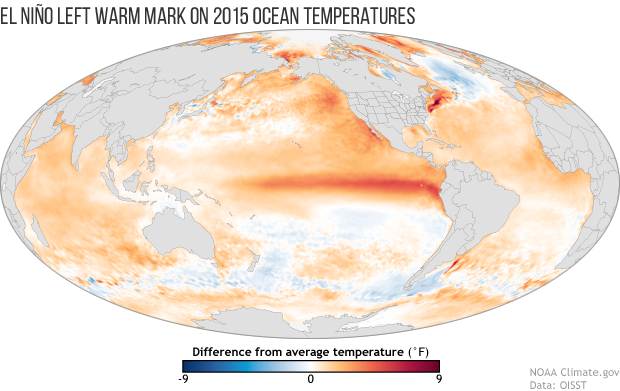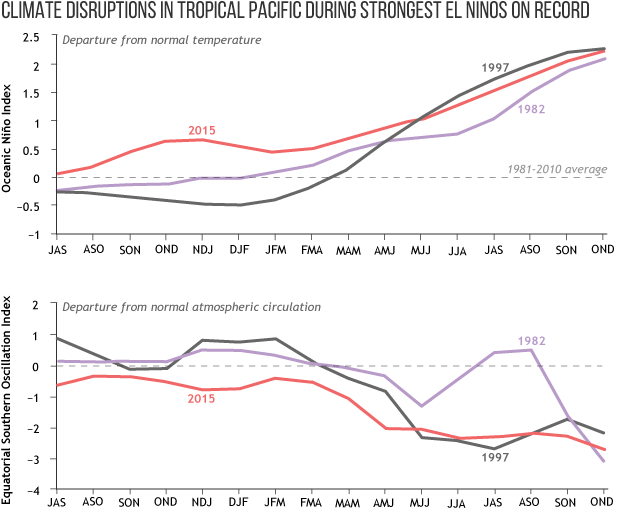2015 State of the Climate: El Niño came, saw, and conquered

A record-smashing hurricane season in the central North Pacific. Water rationing in Puerto Rico. The biggest one-year jump in atmospheric carbon dioxide concentrations on record. Severe drought in Ethiopia. The hottest global surface temperature—by one of the largest margins—on record.
Those are just a few of 2015’s major climate happenings documented in the recently releasedState of the Climate 2015 report from NOAA and the American Meteorological Society. While the events were scattered across the globe, they all had one thing in common: they were all connected to one of the three strongest El Ninõs in the historical record.

A Pacific pattern with a global echo
El Niño is the warm phase of a natural climate pattern called “ENSO,” which is short for El Niño-Southern Oscillation. During El Niño, the prevailing winds near the equator in the Pacific relax. Surface waters in the central and eastern Pacific warm up. A major hotspot of tropical rainfall and convection (rising air) develops over the warm waters.
The warm up for the 2015 El Niño event actually began in 2014. Monthly sea surface temperatures in a key ENSO-monitoring region hit the El Niño threshold—0.5°C above average—in October 2014 and remained elevated through winter. But the atmosphere didn’t fully start cooperating until March 2015, when NOAA forecasters declared El Niño officially underway.
By December 2015*, however, disruptions in temperature, rainfall, and surface air pressure across the tropical Pacific were on par with two of the strongest El Niños in the historical record: 1982 and 1997.
UN to Probe Whether Iconic Secretary-General Was Assassinated
Newly discovered documents revive claim that Dag Hammarskjold may have been killed by South African agents backed by the CIA.
False Flags Fluttering in the Empire’s Hot Air
The good news for the US “deep state” is that Blacks in the US can very much accomplish the same function as the refugees do in Europe: they are a vocal, mostly deeply alienated minority, with a great deal of pent-up anger against the rest of society which can very easily be set-off to create riots and commit crimes. It is also rather easy to find a few crazies amongst them to start murdering policemen (the ideal symbol of the oppression) and create a sense of crisis acute enough justify the use of police, National Guard and, potentially, military forces to restore and uphold “law and order”.
The Coming War on ChinaJohn Pilger talks about China, Okinawa, and U.S. policy in Asia.
Sugar-Coated Lies: How The Food Lobby Destroys Health
Simply because the food industry is able to resist regulation. The CEO report notes that the food industry has vigorously mobilised to stop vital public health legislation
http://www.countercurrents.
Could Inflation Break the Back of the Status Quo?


Could Inflation Break the Back of the Status Quo?
Political resistance to the oligarchy's financialization skimming operations will eventually cripple central bank giveaways to the financial sector and corporate oligarchs.
That inflation and interest rates will remain near-zero for a generation is accepted as "obvious" by virtually the entire mainstream media. The reasons for this are equally "obvious": central banks have the power to suppress interest rates indefinitely by creating money out of thin air and using this new cash to buy bonds in unlimited quantities; and the commoditization/ globalization of labor, capital and production has generated a global backdrop of over-capacity and near-zero pricing power.
But suppose for a moment that this confidence in near-zero interest rates and inflation as far as the eye can see is wrong. As I have demonstrated this week,rising interest rates and inflation would break the back of the status quo.
What makes inflation difficult to grasp is its multi-faceted character. Inflation is a monetary dynamic, to be sure, as creating new fiat currency in excess of increasing production / productivity reduces the purchasing power of the currency.
But as I have shown this week, inflation is also one result of cartel capitalism, in which politically powerful cartels can raise prices and reduce quantity and quality without fear of consumers going elsewhere because the cartels have effectively eliminated competition via regulatory capture, lobbying and the immense advantages of unlimited credit from central banks.

Inflation is also tied to the incentives for fraud in our system: lowering quality as a means of Inflation Hidden in Plain Sight increases profits at the expense of consumers who have few means to detect and measure the reduction in the value of what their money buys.
Inflation is also the result of revenue-hungry governments which jack up junk fees, stealth taxes and outright taxes while delivering lower quality services.
